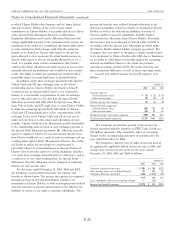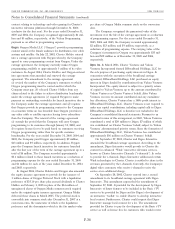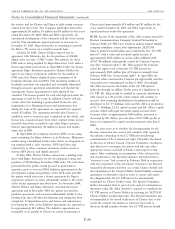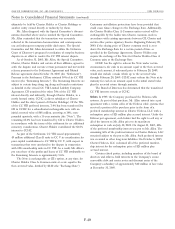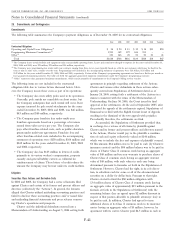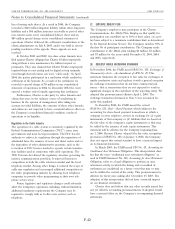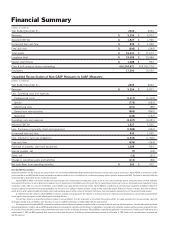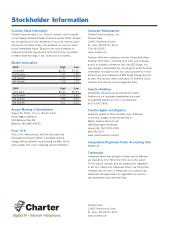Charter 2005 Annual Report Download - page 160
Download and view the complete annual report
Please find page 160 of the 2005 Charter annual report below. You can navigate through the pages in the report by either clicking on the pages listed below, or by using the keyword search tool below to find specific information within the annual report.
CHARTER COMMUNICATIONS, INC. AND SUBSIDIARIES 2005 FORM 10-K
Notes to Consolidated Financial Statements (continued)
lieu of issuing such shares. As a result in 2004, the Company 27. EMPLOYEE BENEFIT PLAN
recorded a $149 million litigation liability within other long-term The Company’s employees may participate in the Charter
liabilities and a $64 million insurance receivable as part of other Communications, Inc. 401(k) Plan. Employees that qualify for
non-current assets on its consolidated balance sheet and an participation can contribute up to 50% of their salary, on a pre-
$85 million special charge on its consolidated statement of tax basis, subject to a maximum contribution limit as determined
operations. Charter delivered the settlement consideration to the by the Internal Revenue Service. The Company matches 50% of
claims administrator on July 8, 2005, and it was held in escrow the first 5% of participant contributions. The Company made
pending resolution of the appeals. Those appeals are now contributions to the 401(k) plan totaling $6 million, $7 million
resolved. and $7 million for the years ended December 31, 2005, 2004
In October 2001 and 2002, two class action lawsuits were and 2003, respectively.
filed against Charter alleging that Charter Holdco improperly
charged them a wire maintenance fee without request or 28. RECENTLY ISSUED ACCOUNTING STANDARDS
permission. They also claimed that Charter Holdco improperly
In November 2004, the FASB issued SFAS No. 153, Exchanges of
required them to rent analog and/or digital set-top terminals Non-monetary Assets — An Amendment of APB No. 29. This
even though their television sets were ‘‘cable ready.’’ In April
statement eliminates the exception to fair value for exchanges of
2004, the parties participated in a mediation which resulted in
similar productive assets and replaces it with a general exception
settlement of the lawsuits. As a result of the settlement, we
for exchange transactions that do not have commercial sub-
recorded a special charge of $9 million in our consolidated
stance — that is, transactions that are not expected to result in
statement of operations in 2004. In December 2004 the court
significant changes in the cash flows of the reporting entity. We
entered a written order formally approving that settlement.
adopted this pronouncement effective April 1, 2005. The
Furthermore, Charter is also party to, other lawsuits and
exchange transaction discussed in Note 3 was accounted for
claims that arose in the ordinary course of conducting its
under this standard.
business. In the opinion of management, after taking into
In December 2004, the FASB issued the revised
account recorded liabilities, the outcome of these other lawsuits
SFAS No. 123, Share — Based Payment, which addresses the
and claims are not expected to have a material adverse effect on
accounting for share-based payment transactions in which a
the Company’s consolidated financial condition, results of
company receives employee services in exchange for (a) equity
operations or its liquidity.
instruments of that company or (b) liabilities that are based on
the fair value of the company’s equity instruments or that may
Regulation in the Cable Industry
be settled by the issuance of such equity instruments. This
The operation of a cable system is extensively regulated by the
statement will be effective for the Company beginning Janu-
Federal Communications Commission (‘‘FCC’’), some state
ary 1, 2006. Because Charter adopted the fair value recognition
governments and most local governments. The FCC has the
provisions of SFAS No. 123 on January 1, 2003, the Company
authority to enforce its regulations through the imposition of
does not expect this revised standard to have a material impact
substantial fines, the issuance of cease and desist orders and/or
on its financial statements.
the imposition of other administrative sanctions, such as the
In March 2005, the FASB issued FIN No. 47, Accounting for
revocation of FCC licenses needed to operate certain transmis- Conditional Asset Retirement Obligations. This interpretation clari-
sion facilities used in connection with cable operations. The
fies that the term ‘‘conditional asset retirement obligation’’ as
1996 Telecom Act altered the regulatory structure governing the
used in FASB Statement No. 143, Accounting for Asset Retirement
nation’s communications providers. It removed barriers to Obligations, refers to a legal obligation to perform an asset
competition in both the cable television market and the local
retirement activity in which the timing and/or method of
telephone market. Among other things, it reduced the scope of
settlement are conditional on a future event that may or may
cable rate regulation and encouraged additional competition in
not be within the control of the entity. This pronouncement is
the video programming industry by allowing local telephone
effective for fiscal years ending after December 15, 2005. The
companies to provide video programming in their own tele-
adoption of this interpretation did not have a material impact
phone service areas.
on our financial statements.
Future legislative and regulatory changes could adversely
Charter does not believe that any other recently issued, but
affect the Company’s operations, including, without limitation,
not yet effective accounting pronouncements, if adopted, would
additional regulatory requirements the Company may be
have a material effect on the Company’s accompanying financial
required to comply with as it offers new services such as
statements.
telephone.
F-42





